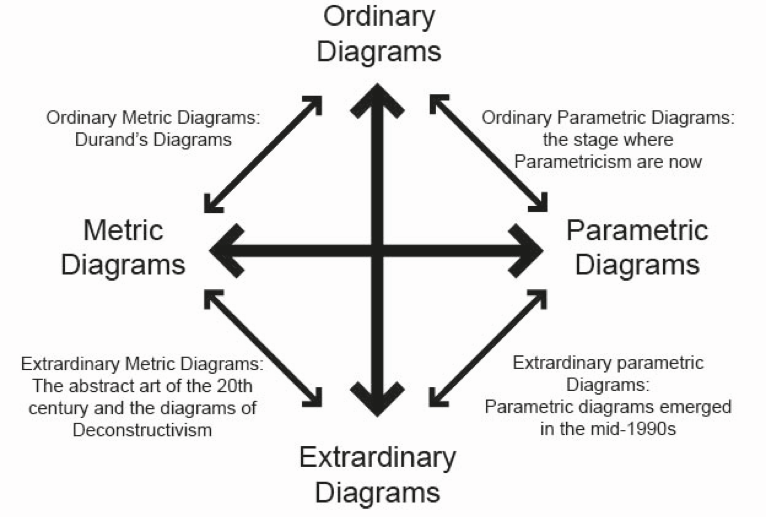Rise of Parametricism? Thinking in Parametric Diagrams
- Walter Wong
- Nov 6, 2017
- 3 min read

Having the first project brief about “Fluid architecture”, different design approaches have been proposed in our studio to strive for the best, while parametric design is one of the popular typologies being experimented and probed by our colleagues. In fact, the focus of avant-garde architectural design has been shifting to the presentation in parametricism. With reference to the essay “Parametric Diagrams” written by Patrik Schumacher (Zaha Hadid Architects), some of us start exploring the possibilities and potential of parametric diagrams when comparing to other conventional diagrams.
To understand the nature of parametric diagrams, we try to redefine and delve into the ordinary diagram and extraordinary diagram. Undoubtedly, the concept of ordinary diagram is firmly lodged in a routine practice, and it functions within a stable translation of social practice. And the extraordinary diagram can usually be related to how Deleuze, a famous French philosopher in 20th century who focused on discerning the ultimate surrealistic nature in the reality, distinguishes diagrams from typical representations. For the extraordinary (Deleuzian) diagram, no defining routine practice has yet crystallised. Instead, it is creatively engaged in the formation of practice that is potentially reproducible, and therefore this worked in a way without a stable for of interpretations, predetermined consequences or constraints. The crucial difference between ordinary and extraordinary diagrams does not reside within the graphic or digital object itself, but in the patterns and logics of its use.
Similarly, for the metric and parametric diagrams, the attributes of the graphic/digital primitives of the metric diagram are fully determined and fixed any time. But in the parametric diagram, the attributes of the graphic/digital primitives remain variable and only constrained within a defined range.
The distinction between ordinary and extraordinary concerns the external embedding of the diagram within the rationality of an encompassing design process. While the distinction between metric and parametric diagram concerns the internal constitution of the diagram. The comparison and interpretation in these two distinctions allows the possible orthogonal operation and combination of these four expressions in diagrams.

Figure 1: The orthogonal operation and combination of the four expressions in diagrams
The development into the ordinary parametric diagrams drives the pervasion of Parametricism into the contemporary architecture, especially within the architectural avant-garde discourse. Parametricism can be seen as a new style after Modernism, and Postmodernism and Deconstructivism were the transitional episodes to this new innovation.
The rising of Parametricism is interrelated to the context of social and architectural evolution. In the past, the mass society was characterised by a single, nearly universal consumption standard. However nowadays, it has evolved into a heterogeneous society of the multitude. In correspondence of the social transition, contemporary architecture finds itself at the midpoint an ongoing cycle of innovative adaptation – retooling the discipline and adapting the architectural and urban environment to the socioeconomic era of post-Fordism. Hence, the key focus of the avant-garde architecture and urbanism started shifting to the organisation and articulation of the increased complexity of this post-Fordism society, and the pervasion of Parametricism becomes inevitable. It was due to how Parametricism can emerge from the creative exploitation of parametric design systems in view of articulating the multi-various processes and institutions for this complex society.
This sets up the new task for Parametricist to create complex, polycentric urban fields which are densely layered and continuously differentiated. To achieve this task, Parametricism will undeniably reply on the use of computationally advanced design techniques, and our studio has been exploring the heuristics carefully. The positive heuristics like hybridise, morph, deterritorialise, deform, iterate, also the negative heuristics such as avoid familiar typologies, avoid hermetic objects, avoid juxtaposition of unrelated elements or systems.
Despite Parametricism relies heavily on sophisticated parametric techniques, the parametric design tools by themselves cannot account for the drastic stylistic shift from Modernism to Parametricism. It’s the Parametricist sensibility in maximal emphasis on differentiation makes the change. Just like how Norman Foster is using the parametric setups to absorb complexity with a minimum inconspicuous differentiation, which results in the maintenance of his Modernist aesthetics.
We can foresee the new challenge for our studio will be how we develop our sensibility in choosing the optimal and innovative approach to illustrate the resilient concept, just like how Parametricist plays with the Deleuzian design to articulate the needs of our variegated society.
Two more weeks to go for the review on 27/11/2017, do follow and subscribe our blog, our ambitious and radical design is coming up soon.



Comments